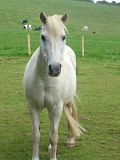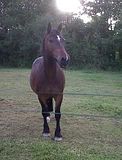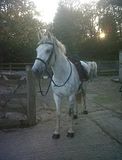Post by ceej on Oct 24, 2011 6:58:49 GMT
Earlier in the summer M, whilst she was still at L's developed these big scabby lumps - they really irritaed her and were predominintly over her withers. They continue to erupt on and off all summer. L thought it was an allergic reaction to something but hibiscrubbed her and demoline shampooed her. Since she has been with me/been clipped they have all but gone - I wondered whether it was to do with her being hot and I dont over rug so thought maybe thats why they went.
Anyway noticed Willow has been a bit itchy recently and yesterday I gave Willow a little bib clip as he gets so hot in autumn as he has a massive coat. He is covered in these lumps also - mainly on one side, on the side of his belly. They are large (some half gold ball size) and some have dark, bloody scabs on them. I am not sure if the scabs are from itching them but M had scabs in places she could not have reached so I dont think so.
I cant work out what they may be. I think its a huge coincidence that Willow gets them just a month after M arrives when I ahve never seen them before.
I have read that it could be:
ONCHOCERCIASIS.
This is an unfortunate allergic skin condition due to juvenile worms (microfilariae) produced by female onchocerca or Neck Threadworm. These females live in the ligaments of the neck and rarely the flexor tendons and suspensory ligaments of the fetlock. The juveniles produced, migrate to the skin surface creating itchy lumps under the skin of the underside of the chest, abdomen, withers, neck and face. Hence the horse may rub and cause excoriations to the skin, enabling serum to seep out. These open wounds will attract biting insects, which then ingest the juvenile worms when feeding and can then transmit the worms to other horses within 20-25 days of ingesting them. This lifecycle completes in about 4-5 months.
Symptoms:-Typically, lesions are found on the underside of horses in the belly, chest, withers, neck and face areas. These lesions can vary from pea size to marble size and create intense itching so that the horse rubs off the hair in that area. Thus weepy and scabby lesions culminate in the area and when hair does re-grow it is often white.
Prevention and treatment:- The best way to prevent this condition is through the control of biting insects. Horses can be stabled and rugged day and night and screens in the stables could be installed during the summer. Oral pastes are often used to control the juvenile worms that cause the intense itching.Unfortunately, after this treatment they may become even more itchy within 24-72 hours.
ewww - At first I thought it cant be that as there has not been enough time for a cycle of worms since M arrived but M was here earlier in the summer twice so I dont think its a coincidence. But the wormert only kills the juvenille worm causing the reaction, not the adult layers so it keeps coming back. I really hope its not that,
But also that it could be hives from an allergic reaction.
Im off to buy some Ivermectin (which i have read is best to kill them off today but Im a bit pissed of my poor chap has this
Has anyone ever had anything similar? ill try to take some pics - do you think I should clip him out and bath him? I cant bath him with his coat, he would never dry catch cold.
Anyway noticed Willow has been a bit itchy recently and yesterday I gave Willow a little bib clip as he gets so hot in autumn as he has a massive coat. He is covered in these lumps also - mainly on one side, on the side of his belly. They are large (some half gold ball size) and some have dark, bloody scabs on them. I am not sure if the scabs are from itching them but M had scabs in places she could not have reached so I dont think so.
I cant work out what they may be. I think its a huge coincidence that Willow gets them just a month after M arrives when I ahve never seen them before.
I have read that it could be:
ONCHOCERCIASIS.
This is an unfortunate allergic skin condition due to juvenile worms (microfilariae) produced by female onchocerca or Neck Threadworm. These females live in the ligaments of the neck and rarely the flexor tendons and suspensory ligaments of the fetlock. The juveniles produced, migrate to the skin surface creating itchy lumps under the skin of the underside of the chest, abdomen, withers, neck and face. Hence the horse may rub and cause excoriations to the skin, enabling serum to seep out. These open wounds will attract biting insects, which then ingest the juvenile worms when feeding and can then transmit the worms to other horses within 20-25 days of ingesting them. This lifecycle completes in about 4-5 months.
Symptoms:-Typically, lesions are found on the underside of horses in the belly, chest, withers, neck and face areas. These lesions can vary from pea size to marble size and create intense itching so that the horse rubs off the hair in that area. Thus weepy and scabby lesions culminate in the area and when hair does re-grow it is often white.
Prevention and treatment:- The best way to prevent this condition is through the control of biting insects. Horses can be stabled and rugged day and night and screens in the stables could be installed during the summer. Oral pastes are often used to control the juvenile worms that cause the intense itching.Unfortunately, after this treatment they may become even more itchy within 24-72 hours.
ewww - At first I thought it cant be that as there has not been enough time for a cycle of worms since M arrived but M was here earlier in the summer twice so I dont think its a coincidence. But the wormert only kills the juvenille worm causing the reaction, not the adult layers so it keeps coming back. I really hope its not that,
But also that it could be hives from an allergic reaction.
Im off to buy some Ivermectin (which i have read is best to kill them off today but Im a bit pissed of my poor chap has this

Has anyone ever had anything similar? ill try to take some pics - do you think I should clip him out and bath him? I cant bath him with his coat, he would never dry catch cold.







